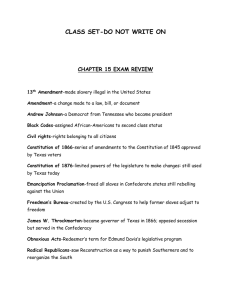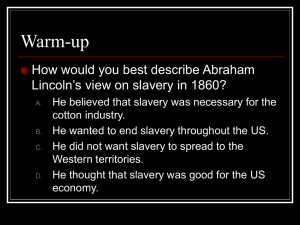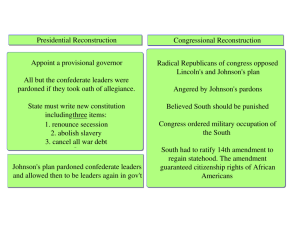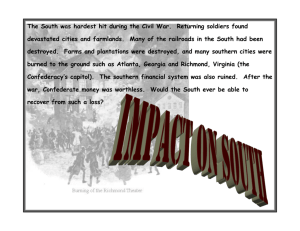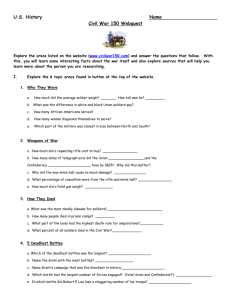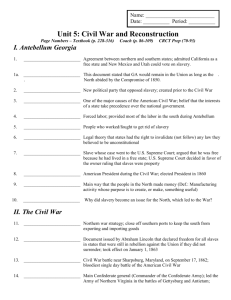File - Important Information
advertisement
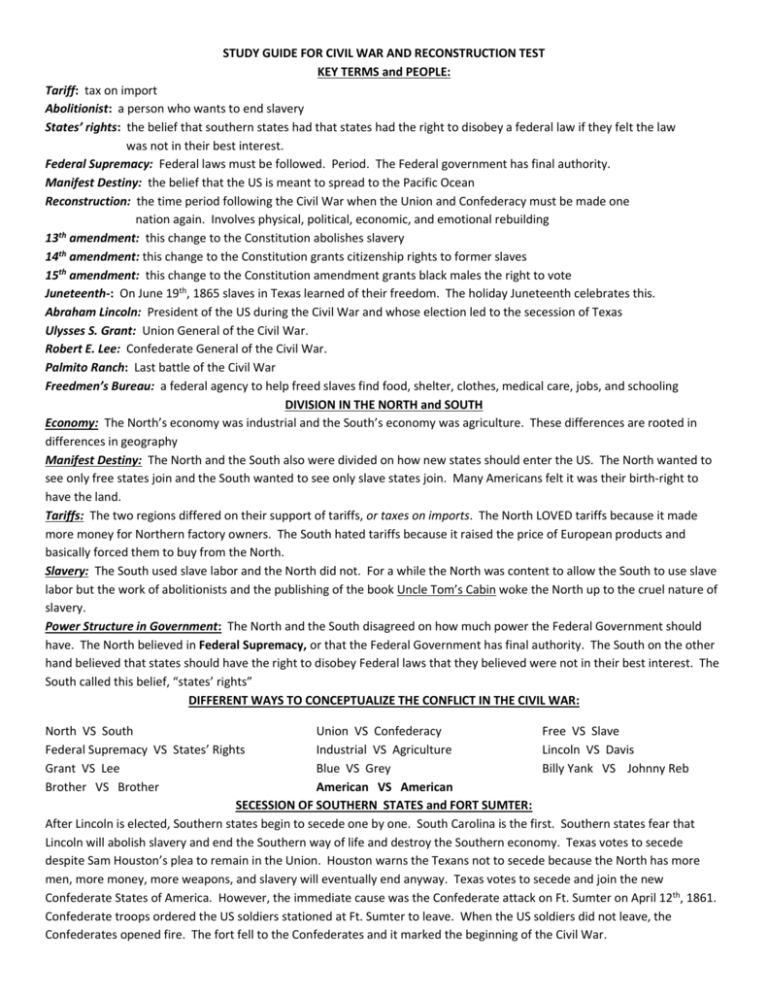
STUDY GUIDE FOR CIVIL WAR AND RECONSTRUCTION TEST KEY TERMS and PEOPLE: Tariff: tax on import Abolitionist: a person who wants to end slavery States’ rights: the belief that southern states had that states had the right to disobey a federal law if they felt the law was not in their best interest. Federal Supremacy: Federal laws must be followed. Period. The Federal government has final authority. Manifest Destiny: the belief that the US is meant to spread to the Pacific Ocean Reconstruction: the time period following the Civil War when the Union and Confederacy must be made one nation again. Involves physical, political, economic, and emotional rebuilding th 13 amendment: this change to the Constitution abolishes slavery 14th amendment: this change to the Constitution grants citizenship rights to former slaves 15th amendment: this change to the Constitution amendment grants black males the right to vote Juneteenth-: On June 19th, 1865 slaves in Texas learned of their freedom. The holiday Juneteenth celebrates this. Abraham Lincoln: President of the US during the Civil War and whose election led to the secession of Texas Ulysses S. Grant: Union General of the Civil War. Robert E. Lee: Confederate General of the Civil War. Palmito Ranch: Last battle of the Civil War Freedmen’s Bureau: a federal agency to help freed slaves find food, shelter, clothes, medical care, jobs, and schooling DIVISION IN THE NORTH and SOUTH Economy: The North’s economy was industrial and the South’s economy was agriculture. These differences are rooted in differences in geography Manifest Destiny: The North and the South also were divided on how new states should enter the US. The North wanted to see only free states join and the South wanted to see only slave states join. Many Americans felt it was their birth-right to have the land. Tariffs: The two regions differed on their support of tariffs, or taxes on imports. The North LOVED tariffs because it made more money for Northern factory owners. The South hated tariffs because it raised the price of European products and basically forced them to buy from the North. Slavery: The South used slave labor and the North did not. For a while the North was content to allow the South to use slave labor but the work of abolitionists and the publishing of the book Uncle Tom’s Cabin woke the North up to the cruel nature of slavery. Power Structure in Government: The North and the South disagreed on how much power the Federal Government should have. The North believed in Federal Supremacy, or that the Federal Government has final authority. The South on the other hand believed that states should have the right to disobey Federal laws that they believed were not in their best interest. The South called this belief, “states’ rights” DIFFERENT WAYS TO CONCEPTUALIZE THE CONFLICT IN THE CIVIL WAR: North VS South Union VS Confederacy Free VS Slave Federal Supremacy VS States’ Rights Industrial VS Agriculture Lincoln VS Davis Grant VS Lee Blue VS Grey Billy Yank VS Johnny Reb Brother VS Brother American VS American SECESSION OF SOUTHERN STATES and FORT SUMTER: After Lincoln is elected, Southern states begin to secede one by one. South Carolina is the first. Southern states fear that Lincoln will abolish slavery and end the Southern way of life and destroy the Southern economy. Texas votes to secede despite Sam Houston’s plea to remain in the Union. Houston warns the Texans not to secede because the North has more men, more money, more weapons, and slavery will eventually end anyway. Texas votes to secede and join the new Confederate States of America. However, the immediate cause was the Confederate attack on Ft. Sumter on April 12th, 1861. Confederate troops ordered the US soldiers stationed at Ft. Sumter to leave. When the US soldiers did not leave, the Confederates opened fire. The fort fell to the Confederates and it marked the beginning of the Civil War. STRENGHTS AND WEAKNESSES OF THE UNION AND CONFEDERACY: Union Strengths Union Weaknesses -more soldiers -had to invade the South -more weapons/supplies -inexperienced soldiers -more money -poor military leaders (esp. at beginning of war) -more transportation options -had to fight in unfamiliar terrain Confederate Strengths -good military leaders -“Home field Advantage” -only had to fight a defensive war -motivated soldiers -long coastline (difficult to blockade) Confederate Weaknesses -fewer Soldiers -fewer Supplies -less money (weaker economy) STRATEGIES TO WIN THE WAR: NORTH: “ANACONDA PLAN” 1. Blockade the Southern coastline 2. Take control of the Mississippi River to split the Confederacy 3. Attack deep into the Confederacy POLITICAL Texas seceded and joined the Confederate States of America. 1. 2. 3. 4. SOUTH Gain European help Break Union blockade Capture Washington D.C Hold out long enough until Union tires Effects of the War in Texas ECONOMIC The Texas Economy suffered due to the Union blockade and collapse of the Confederate currency. SOCIAL Leads to the end of slavery Homefront hardships Texas wrote a new Constitution. Sam Houston was removed as Governor. Will Texas still be able to have an agricultural economy without slaves? Greater roles for women during the war Loss of family members Texas would have to rejoin the United States and write a new Constitution. Some factories were opened in Texas during the Civil War to manufacture war goods. RECONSTRUCTION PLANS: PRESIDENTIAL RECONSTRUCTION 1. 13th amendment only 2. Denounce secession (states’ rights) 3. Cancel all war debts 4. Small percentage must take a loyalty oath to vote CONGRESSIONAL RECONSTRUCTION 1. 13th, 14th, and 15th amendments 2. Denounce secession (states’ rights) 3. Cancel all war debts 4. Must take a loyalty oath to vote 5. No Confederate leaders may hold office 6. South divided into military districts 13th amendment- Abolishes slavery “Reconstruction Amendments” 14th amendment- Citizenship rights 15th amendment- Voting rights for African-American males
